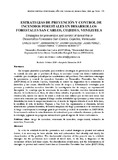| dc.rights.license | http://creativecommons.org/licenses/by-nc-sa/3.0/ve/ | es_VE |
| dc.contributor.author | Silva, Carlos | |
| dc.contributor.author | Barreto, Juan | |
| dc.contributor.author | Escalona, Jhonny | |
| dc.contributor.author | Pérez, Jesús | |
| dc.contributor.author | Parra, Vismar | |
| dc.contributor.author | Morante, Carmen | |
| dc.date.accessioned | 2020-12-05T01:20:58Z | |
| dc.date.available | 2020-12-05T01:20:58Z | |
| dc.date.issued | 2020-12 | |
| dc.identifier.issn | 0556-6606 | |
| dc.identifier.uri | http://www.saber.ula.ve/handle/123456789/47175 | |
| dc.description.abstract | En bosques plantados y naturales para establecer estrategias de prevención de incendios o su control, en caso que se produzca el fuego, es necesario contar con datos e información confiable que identifique y clarifique las características del problema. Para establecer estrategias de prevención y control de incendios forestales en Desarrollos Forestales San Carlos (DEFORSA) en el estado Cojedes, Venezuela, se realizó un diagnóstico de la ocurrencia de incendios y sus causas, identificando las zonas de riesgos y determinando estrategias para prevenir y controlar incendios forestales La investigación fue de campo, no experimental descriptiva. Se concluye que la ocurrencia de incendios forestales suceden frecuentemente alejados de los linderos; es decir, de afuera hacia adentro; el promedio de ocurrencia es de 32 eventos/año, siendo los meses de enero a abril los más críticos por ser los más secos. Las causas más comunes que originan el fuego son las actividades agropecuarias y otras causas no detectadas; las áreas de mayor incidencia son: el rincón de Yaguara ubicado al oeste de la finca, la carrillera al este, el lindero Yaguara y San José. La organización y educación, labores silviculturales y faenas forestales, detección temprana del fuego y mecanismos de reacción ante el fuego constituyeron la estrategia para la prevención y control de incendios en DEFORSA. Se recomienda realizar la estandarización de indicadores para evaluar la eficiencia y eficacia de la estrategia; y generar un programa automatizado para el registro de datos e información. | es_VE |
| dc.language.iso | es | es_VE |
| dc.rights | info:eu-repo/semantics/openAccess | es_VE |
| dc.subject | Riesgo de incendios | es_VE |
| dc.subject | Ocurrencia de incendios | es_VE |
| dc.subject | Ataque inicial | es_VE |
| dc.subject | Extinción de incendios | es_VE |
| dc.subject | Venezuela | es_VE |
| dc.title | Estrategias de prevención y control de incendios forestales en desarrollos forestales San Carlos, Cojedes, Venezuela | es_VE |
| dc.title.alternative | Strategies for prevention and control of forest fire in Desarrollos Forestales San Carlos, Cojedes, Venezuela | es_VE |
| dc.type | info:eu-repo/semantics/article | es_VE |
| dcterms.dateAccepted | Diciembre 2019 | |
| dcterms.dateAccepted | Diciembre 2019 | |
| dcterms.dateSubmitted | Octubre 2019 | |
| dcterms.dateSubmitted | Octubre 2019 | |
| dc.description.abstract1 | In order to establish forest fire prevention and control strategies in planted and natural forests, it is necessary to have reliable data and information that identify and clarify the characteristics of the problem. The fundamental objective of this projects was to establish strategies for the prevention and control of forest fires; to do this, a diagnosis of the occurrence of fires and their causes, the identification of risk areas, and the determination of strategies to prevent and control forest fires in Desarrollos Forestales San Carlos (DEFORSA)in Cojedes state, Venezuela, were carried out. It is a descriptive non-experimental field research. It was determined that forest fires frequently occur away from the site boundaries, i.e. from the outside in. On average, 32 events/year were recorded, mostly in the period between January and April, since they present reduced precipitation compared to the rest of the year. The most common causes of fire are agricultural activities and undetected causes. The areas with the highest incidence are the corner of Yaguara, located to the west of the site, the carrillera to the east, the Yaguara boundary, and the San José area. The strategies for the prevention and control of forest fires in DEFORSA consisted of organization and education activities, silvicultural work and forestry tasks, early detection of fires and warning, and fire reaction mechanisms. It is recommended to perform the standardization of indicators to evaluate the efficiency and effectiveness of the strategy and to generate an automated program for data and information recording. | es_VE |
| dc.description.colacion | 75-96 | es_VE |
| dc.description.frecuencia | Anual | |
| dc.identifier.depositolegal | pp195802ME817 | |
| dc.publisher.pais | Venezuela | es_VE |
| dc.subject.facultad | Facultad de Ciencias Forestales y Ambientales | es_VE |
| dc.subject.institucion | Universidad de Los Andes | es_VE |
| dc.subject.keywords | wildfire risk | es_VE |
| dc.subject.keywords | fire occurrence | es_VE |
| dc.subject.keywords | Initial attack | es_VE |
| dc.subject.keywords | Fire suppression | es_VE |
| dc.subject.keywords | Venezuela | es_VE |
| dc.subject.publicacionelectronica | Revista Forestal Venezolana | |
| dc.subject.seccion | Revista Forestal Venezolana: Nota Técnica | es_VE |
| dc.subject.thematiccategory | Medio Ambiente | es_VE |
| dc.subject.tipo | Revistas | es_VE |
| dc.type.media | Texto | es_VE |


